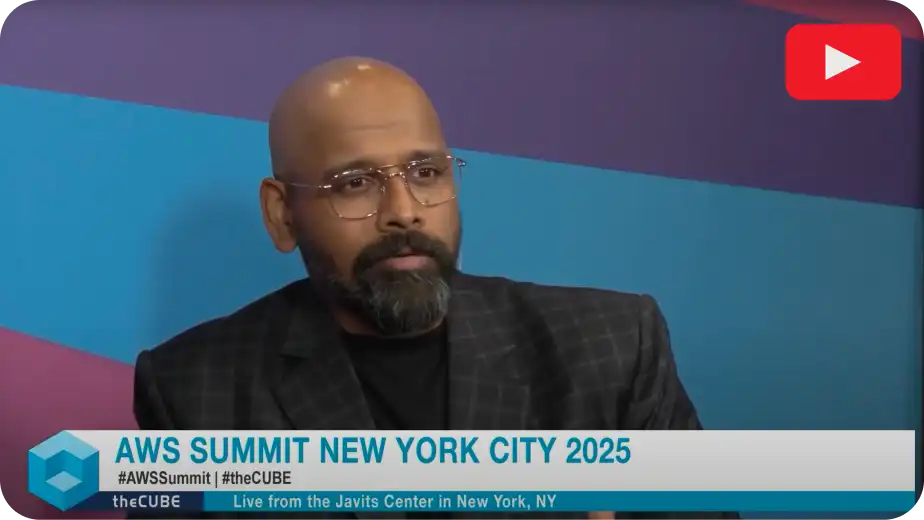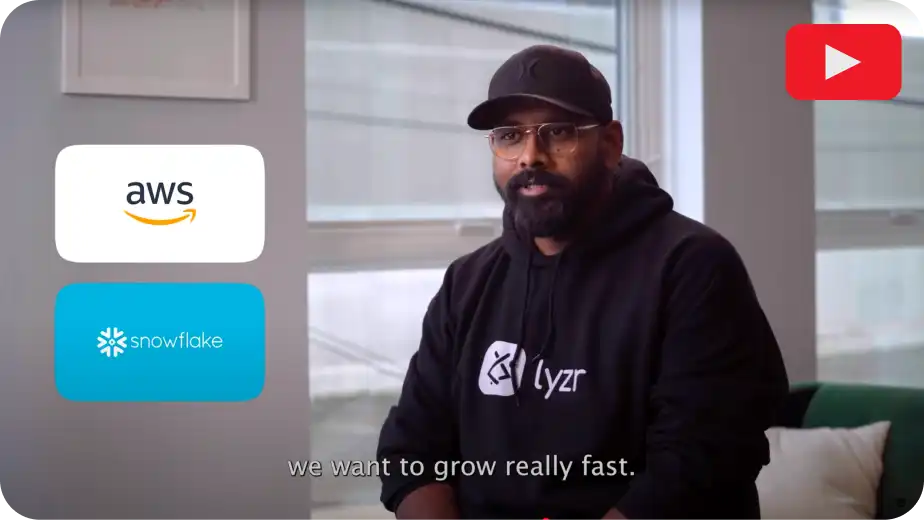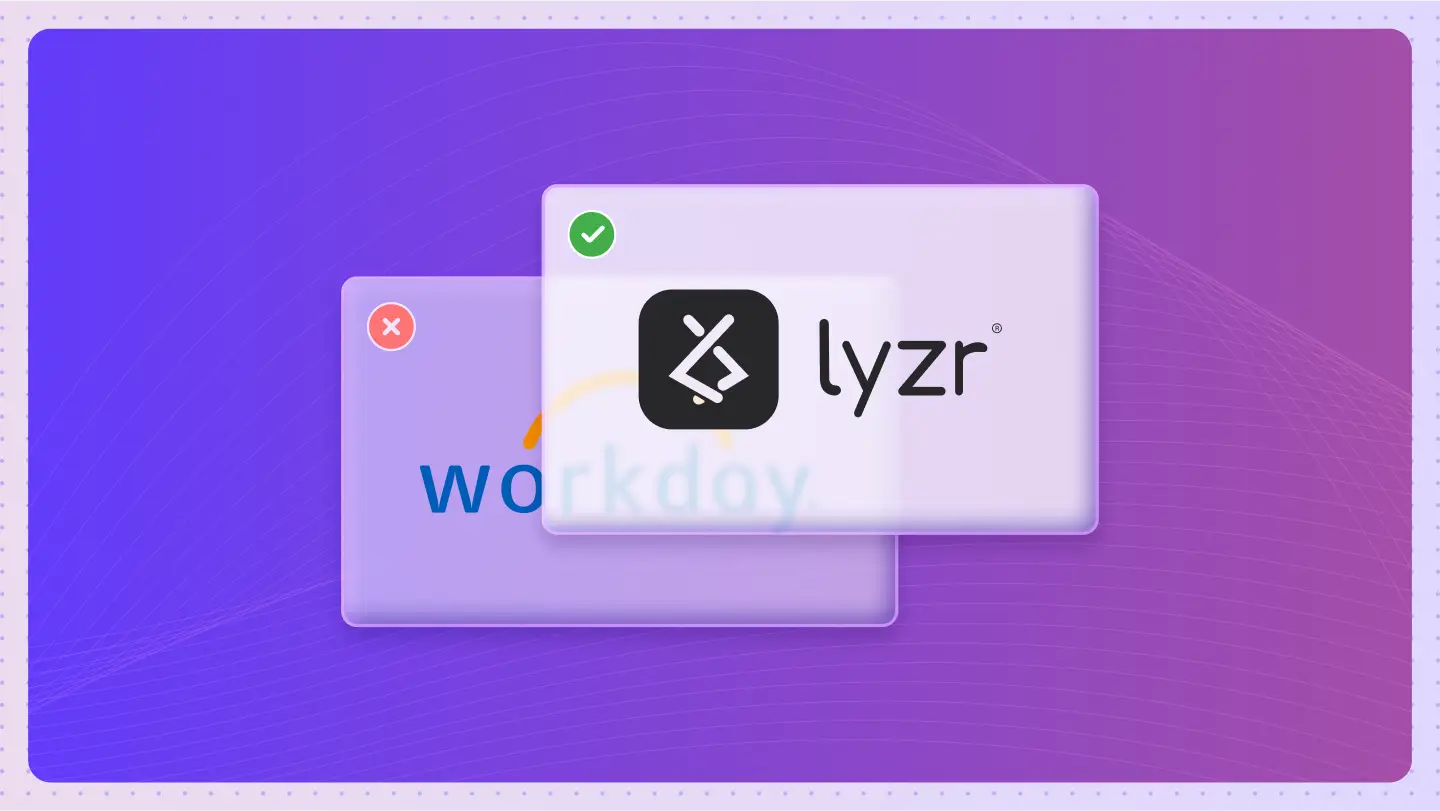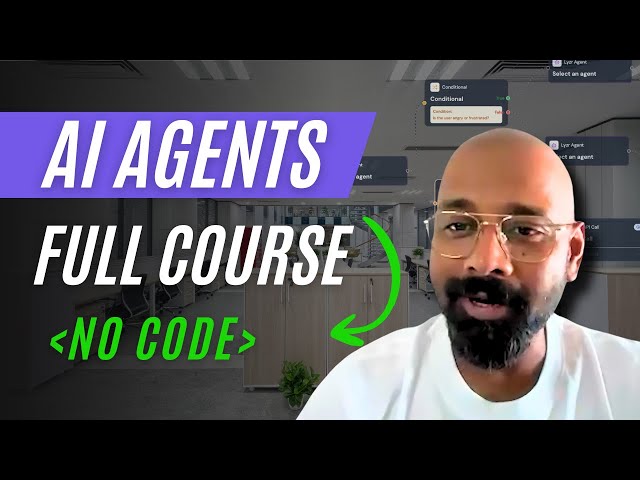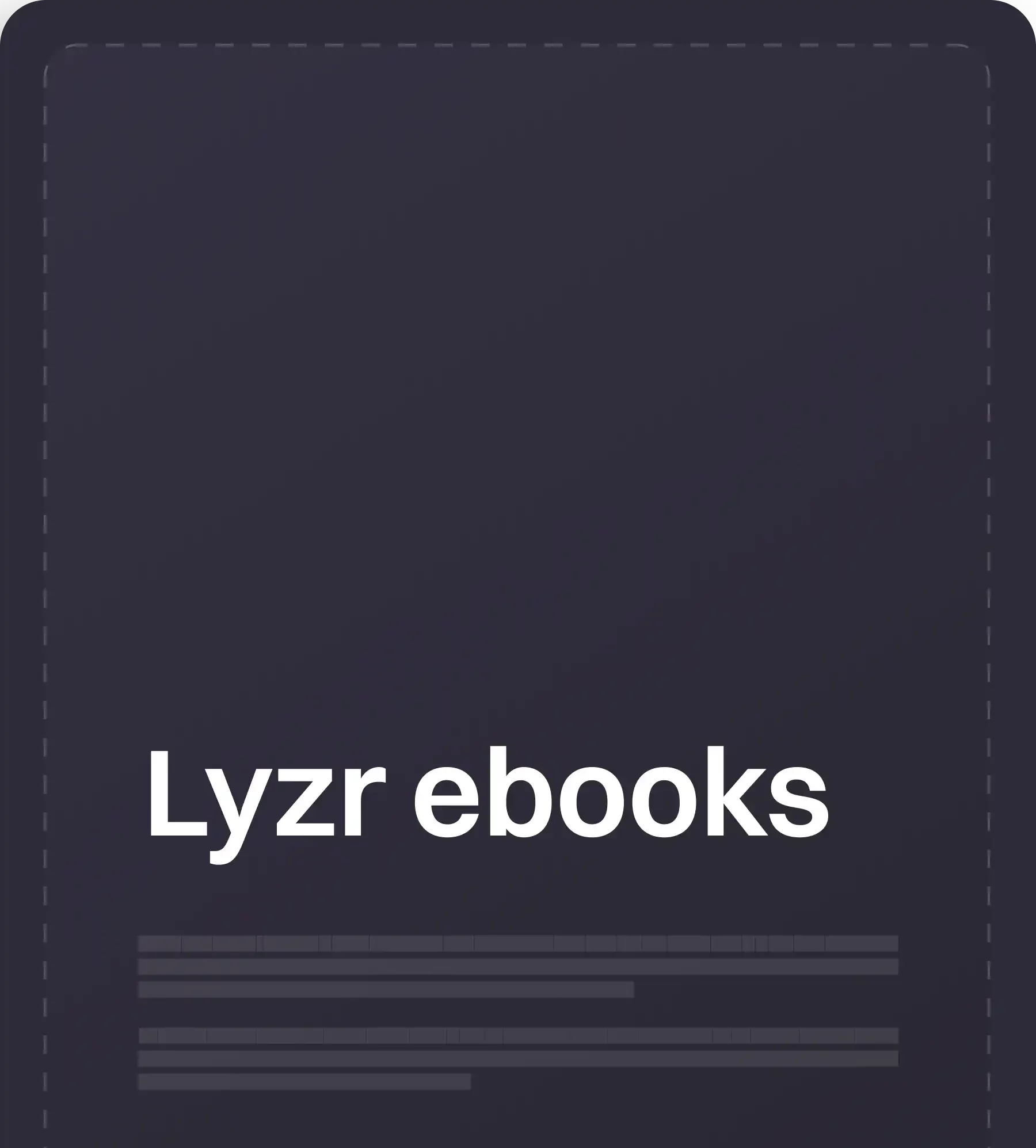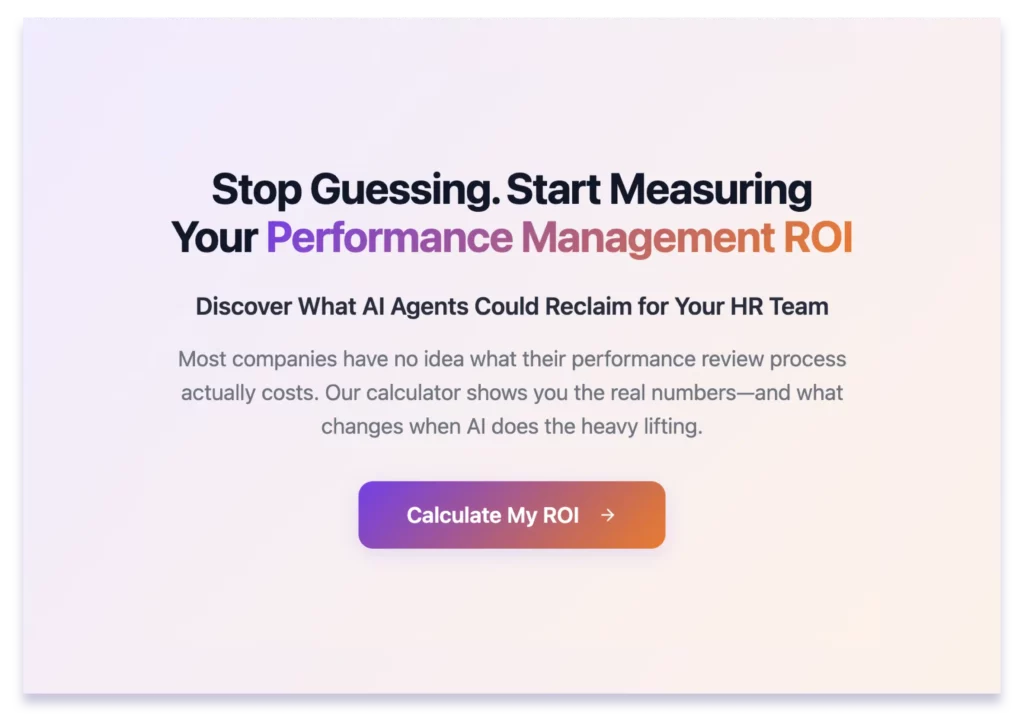TL;DR
Your performance management system costs you $1.47M annually in preventable losses.
AI agents can recover $1.47M/year for $100K investment = 14.7x ROI, 2.8 month payback. This playbook shows you how.
Executive Summary
The Problem: 95% of managers are dissatisfied with performance reviews.(source) Your organization spends 1,280+ hours annually on review coordination that delivers mediocre, biased feedback while your best talent quietly updates their LinkedIn profiles.
The Cost: For a 200-employee organization, broken performance management costs $1.47M+ annually in:
- Preventable turnover ($390K)
- Lost productivity ($1.04M)
- Wasted time ($40K+)
The Solution: AI performance agents that work 24/7 to continuously collect data, synthesize feedback, detect bias, and generate comprehensive reviews automatically. Not AI-assisted tools that make managers slightly faster. Autonomous agents that transform performance management from annual theater into continuous intelligence.
The Proof: Organizations using Lyzr’s AI agents see:
- 60% reduction in manager review time (17 hours → 6 hours per cycle)
- 20% reduction in turnover through better feedback
- 8% productivity gains from continuous coaching
- 2.8 month payback period, 14.7x ROI
What’s Different: HybridFlow architecture prevents AI hallucinations, every claim is grounded in verified company data. Built-in bias detection. Works with your existing HRIS and performance framework. 8-12 week implementation for most organizations.
Who This Is For:
- CHROs who need to prove talent ROI
- Heads of HR tired of review season chaos
- HR Tech Leaders evaluating autonomous AI
- People Leaders drowning in performance data
What’s Inside:
How AI agents work, what implementation actually looks like, and whether your organization is ready (readiness checklist included).
Choose Your Path:
20 minutes? Keep reading for the complete playbook.
5 minutes? Jump to ROI Calculator or Implementation Roadmap
Skeptical? Start with Case Studies & Proof Points
Evaluating alternatives? See How Lyzr Compares to Workday, BambooHR, CrewAI, and Agentforce.
Introduction
The Brutal Truth About Performance Reviews…and why your current processes are failing (miserably)

If this is your organisation, you’re not broken. You’ve just hit the ceiling of what traditional performance management tools can deliver.
Because let’s be honest, most performance reviews are theatre; people act like it works while knowing it doesn’t. And we get it, you’ve tried solving the basics. You’ve implemented performance management platforms, automated review cycles, and digitised feedback collection. You have dashboards, reports, and data flowing through multiple HR systems.
But something’s off, a gap your current stack can’t fill.
The Problem Is Bigger Than You Think (don’t worry: we can fix it)
Employees are 57% less likely than leaders to view performance management processes actually works.
Why?
Because, even with sophisticated HR platforms, these three critical challenges (among many others) remain unresolved:
- You’re Always Too Late to Help: Your systems collect data, but need human intervention to interpret, synthesise, and act on it. By the time HR and managers interpret data, the moment for intervention is gone.
- You’re Stuck Looking Backward: Current tools report the past, but they don’t predict what’s coming, nor can they automatically trigger the right interventions.
- Everyone’s Drowning in Busywork: Managers spend hours compiling reviews instead of actually coaching. HR is buried in spreadsheets instead of solving real problems. And the people who need support? They’re still waiting.
This defaults to recency bias and subjective impressions. And the cost you pay isn’t just bad reviews, it’s stalled career growth, disengaged employees, and performance data that never connects back to business goals.
But guess what? This isn’t a tool problem, it’s an intelligence problem.
Enter AI Agents: The Next Evolution From Assisted to Autonomous
There’s a big difference between tools that help you and agents that do the work for you.
A recent Gartner study found that 62% of HR leaders are testing or piloting AI, and 11% have already adopted it in their processes. The shift is already happening.
- AI-Tools = faster templates, reminders, and basic reports.
- AI Agents = autonomy.
Not the chatbot kind that gives generic advice, but specialised agents that can collect, analyse, and synthesise performance data from across your organisation’s systems. Think proactive agents that:
- Flag potential bias in review language.
- Prompt managers for timely feedback.
- Generate draft reviews based on actual project outcomes and peer input.
This is performance management enablement in real-time, not reporting on what happened last quarter.
Note: This isn’t about replacing human judgment in performance evaluation, it’s about giving that judgment better data to work with.
Why this matters now
Even with modern tools, performance management is still falling short.
- For managers, the problem is overload. There’s way too much data to process and not enough time to turn it into meaningful feedback.
- For HR leaders, the issue is scale. Performance insights stay locked at the individual level instead of rolling up into workforce intelligence.
- For CHROs and People Leaders, the frustration is strategic. Performance data rarely connects back to business outcomes, making it hard to link talent decisions to growth and ROI.
AI agents take that weight off their shoulders. They work in the background, connect the dots across systems, and surface insights exactly when they’re needed most. A coaching nudge for managers, a calibration view for HR, or a workforce trend that helps the CPO plan ahead.
The difference? It happens automatically, continuously, and intelligently without anyone having to ask.
Chapter 1
What’s Your Performance Management Really Costing You?
Let’s talk money.
Not the line items you see on your HR tech invoices. Not the salaries of your People Ops team. We’re talking about the invisible tax your organization pays every single day because your performance management system is stuck in assisted mode.
You know the symptoms. Managers burn 10+ hours per review cycle manually piecing together feedback from five different systems. High performers leaving because their contributions weren’t captured in time. Calibration meetings that feel more like negotiation warfare than talent strategy.But here’s what most CHROs miss: these aren’t just operational headaches. They’re profitability leaks.
The Real Cost of “Good Enough” Performance Management
Your current stack is expensive in ways that never show up in budget reviews:
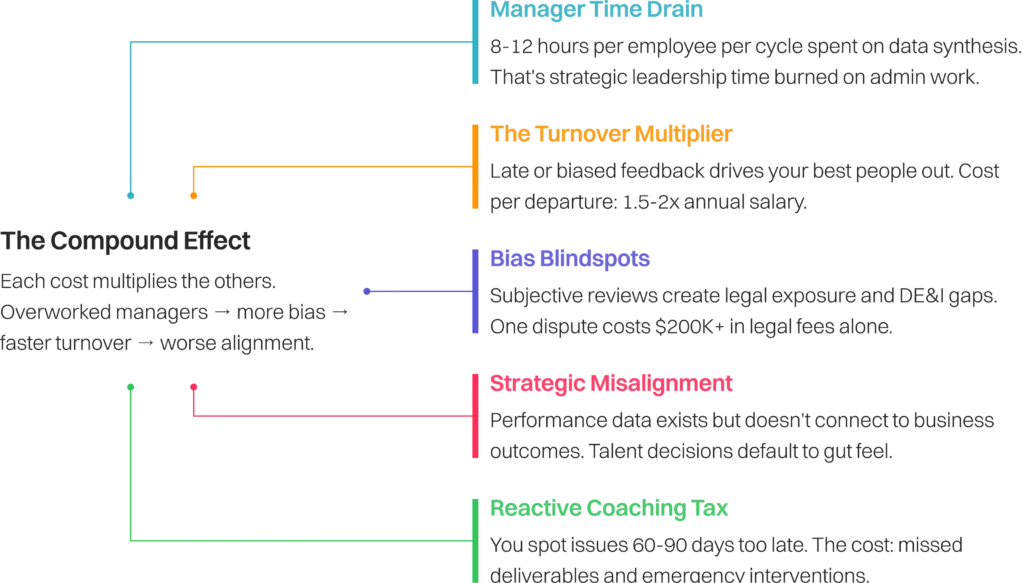
Sound familiar? You’re not alone, but you also don’t have to stay here.
Chapter 2
What If Performance Management Actually Worked?
Stop Imagining. Start Seeing What’s Possible.
You’ve seen the costs. You’ve run the numbers. You know your current system isn’t working.
But here’s the question nobody’s asking: What would it look like if it did work?
Not incrementally better. Not “10% improvement in review completion rates.” We’re talking about performance management that actually drives performance, the kind that makes managers better coaches, employees more engaged, and HR teams strategic instead of stuck in spreadsheets.
Sounds impossible? It’s not. It’s just autonomous.
“The difference between organizations with traditional performance management and those with AI-powered performance intelligence isn’t just about doing the same things faster. It’s also about doing entirely different things that were never possible before.”
The Gap Between What You Have and What’s Possible
Most CHROs we talk to have the same realization around month three of implementing AI performance agents.
It goes something like this: “Oh. This is what performance management was supposed to be all along.”
Because here’s the brutal truth: you’ve been optimizing a broken system. You’ve automated the chaos. You’ve digitized the dysfunction. You’ve made it faster to do the wrong things.
What you haven’t done? Built a system that actually works.
Until now, that wasn’t possible. Performance management that truly drives performance requires continuous intelligence, bias-free synthesis, and proactive interventions. All things that humans can’t scale, no matter how good your training programs are.
But AI agents can.
The World You’re Living In vs. The World That’s Possible
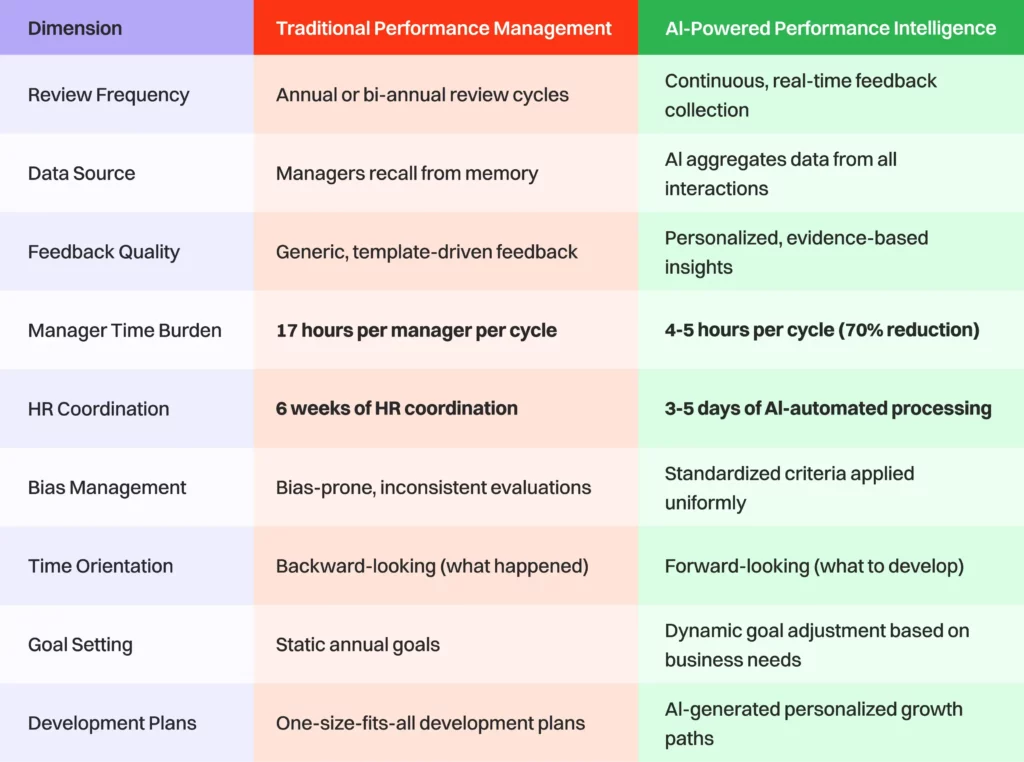
Let those numbers sink in.

What “Actually Working” Looks Like: Sarah’s Story
Let’s get concrete. Here’s what performance management looks like in both worlds:
The Review Experience: Traditional vs AI-Powered
Same employee. Same manager. Completely different outcomes.

Time invested: 17+ hours across all David’s reports
Value delivered: Minimal. Sarah feels invisible, David feels drained, HR has compliance paperwork
Outcome: Sarah starts interviewing elsewhere
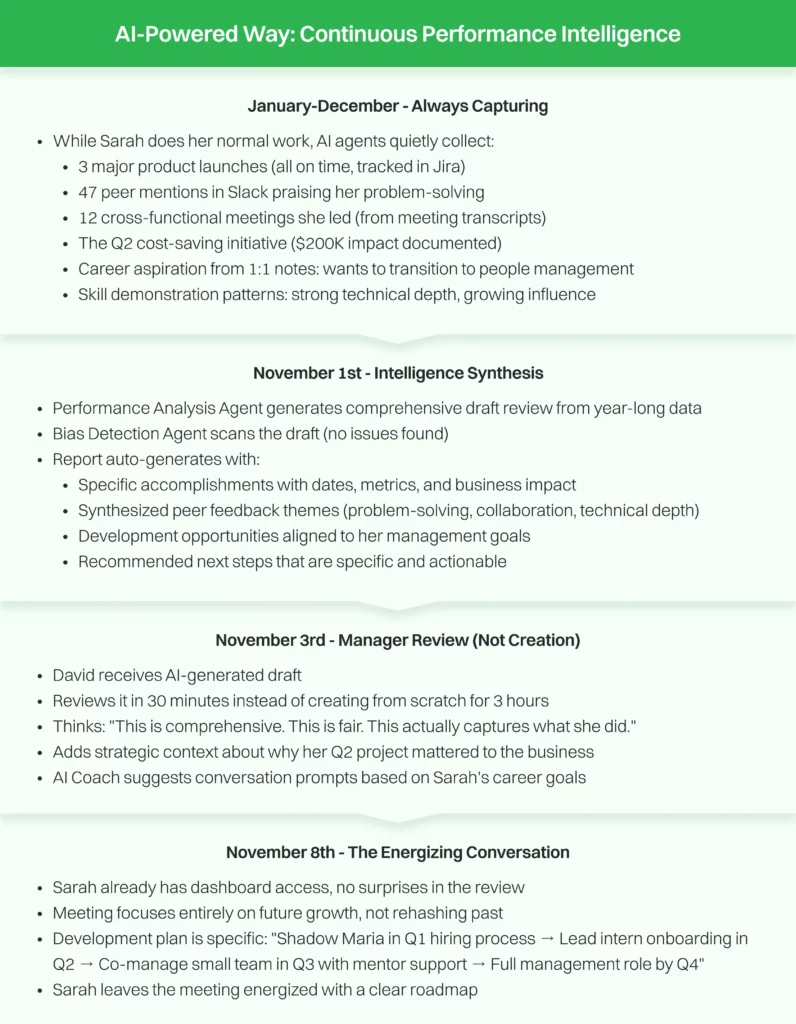
Time invested: 4-5 hours across all David’s reports
Value delivered: High. Sarah feels seen and developed, David feels effective, HR has strategic workforce intelligence
Outcome: Sarah commits to growth path, stays engaged

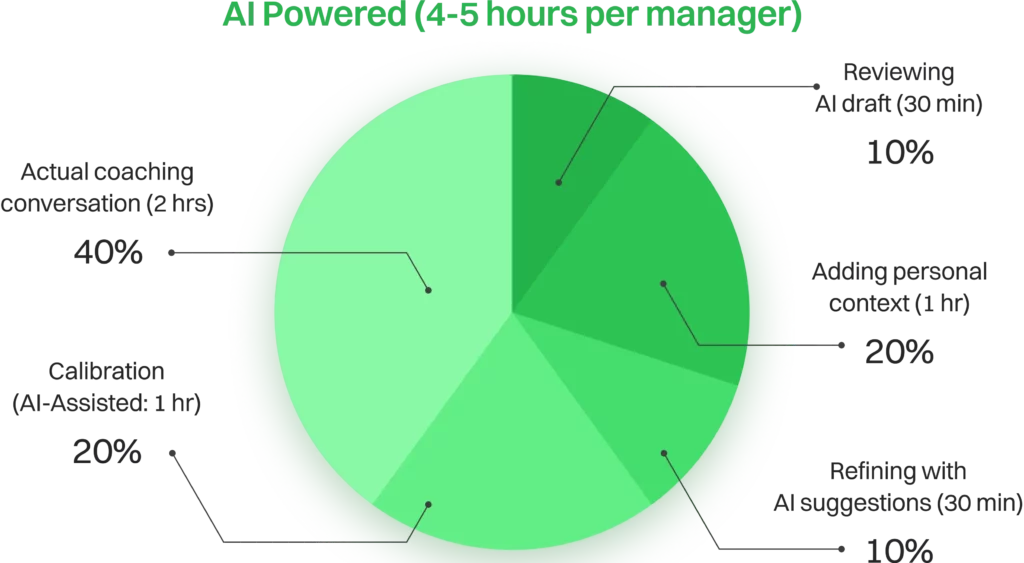
Notice the inversion? The AI-powered approach spends TWICE as much time on actual coaching (2 hrs vs 1 hr) while spending LESS time overall. That’s the entire point.
What Changes for Everyone
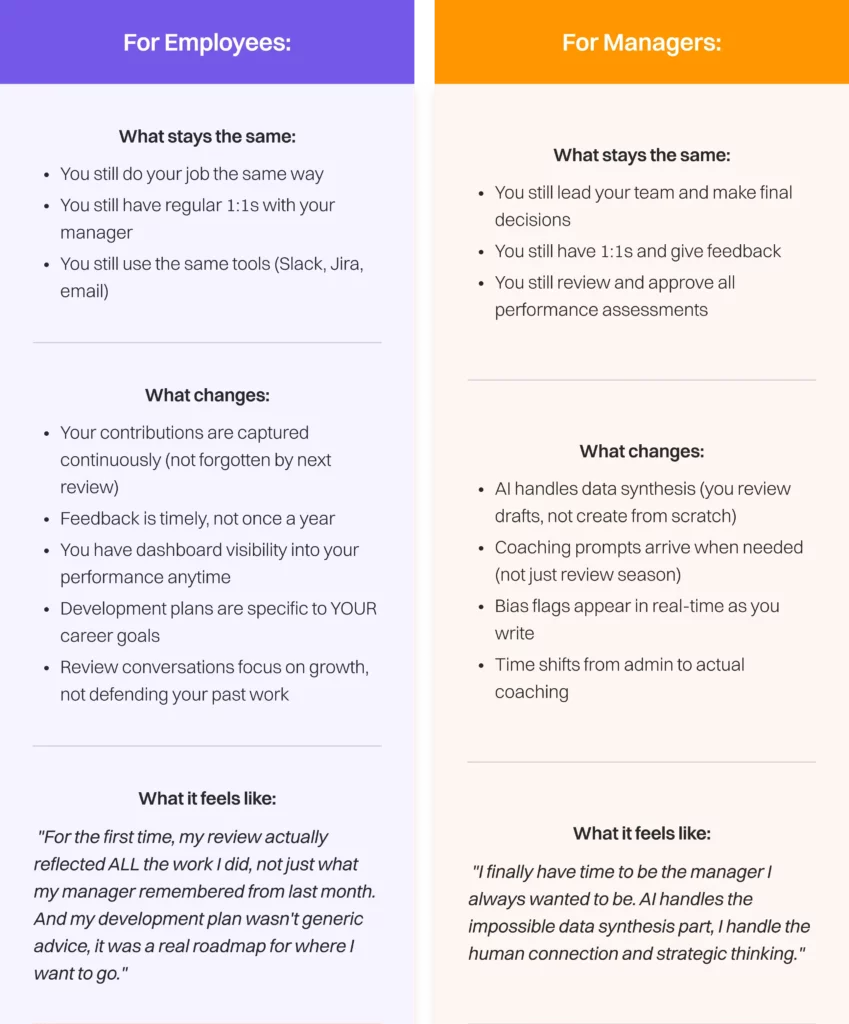

This Isn’t Theory. It’s Reality.
The problems with traditional performance management aren’t opinions. They’re measurable, documented, and cost organizations millions.
95%
of managers are dissatisfied with their organization’s performance review process
CEB (now Gartner), Corporate Leadership Council research
210 hours
per manager annually spent on performance review administration instead of actual coaching
HBR, The Performance Management Revolution
58%
of HR executives rate their performance management system as a “C” grade or lower
Harvard Business Review, “Reinventing Performance Management”
33%
employees want to receive continuous feedback outside of an annual or traditional review.
Joblist survey
What Early Adopters of AI Performance Intelligence Are Seeing
Organizations implementing AI-powered performance systems are beginning to see measurable improvements in both efficiency and quality:
The Numbers Don’t Lie
Real-world results from organizations using AI-powered performance management

- Time Efficiency Gains Support managers using AI tools can handle 13.8% more customer inquiries per hour, demonstrating productivity gains without additional headcount [AI Agent Statistics for 2025: Adoption, ROI, Performance & More]
- Feedback Quality Improvements AI-powered performance systems have shown a 71% increase in employee engagement, a 50% improvement in goal achievement rates, and a 33% reduction in bias during assessments [Performance Management Statistics: What 2025 Holds for HR Leaders]. Research from Betterworks’ 2024 State of Performance Enablement report found that productivity is 29% higher when employees think performance reviews are “very fair,” compared to when they see their reviews as “somewhat biased” [Adopt AI in Performance Management to Drive Business Success – Betterworks].
- Manager Confidence and Support Two in three managers report needing more support to effectively manage performance, with 35% already leveraging AI tools to enhance their efficiency and effectiveness. Additionally, 75% of HR departments are expected to use AI to automate performance reviews and feedback systems. [Adopt AI in Performance Management to Drive Business Success – Betterworks].
- Bias Detection Capabilities Modern AI software delivers unbiased analysis of employee performance by monitoring data inputs in real-time with alerts the instant a bias emerges, fine-tuning technologies to avoid repeating the same errors [How AI Reduces Bias in Employee Performance Reviews]. AI helps overcome unconscious bias issues like recency bias, where managers unintentionally focus only on recent work rather than full-period performance [Employees Want AI in Performance Management – Betterworks].
The Honest Picture: Where We Are Today
AI performance management shows tremendous promise, but successful adoption requires understanding both the opportunity and the challenges
As of 2024, approximately 50% of organizations worldwide have integrated AI tools into their HR departments, with 52% of managers already using AI tools in their roles. The performance management software market is projected to grow from $5.82 billion in 2024 to $12.17 billion by 2032 Thrive SparrowWeCP.
However, a 2025 Stanford study found 78% of workers distrust AI tools handling personal feedback, fearing surveillance or misinterpretation AI Employee Feedback Survey Experience Trends – 2025. This highlights the critical importance of transparent implementation, data governance, and maintaining human oversight in AI-powered performance systems.
This Isn’t a Technology Problem. It’s a Trust Problem
The data shows AI works. The challenge isn’t capability, it’s implementation strategy. Organizations that succeed don’t replace human judgment; they augment it. They maintain transparency, ensure data governance, and keep managers in control of final decisions while AI handles the heavy lifting of data synthesis and bias detection.

The Cost of Waiting:
Every quarter you delay costs your organization $367,500 in preventable losses. Your next review cycle is coming. Will it be the last one that wastes 1,280 hours and drives talent away?
The question isn’t “if” you’ll adopt AI performance agents.
The question is: Will you lead or follow?
Chapter 3
How AI Performance Management Agents Work: The Complete Workflow
The Intelligence Architecture Behind Continuous Performance Management
You’ve seen what’s possible. Now let’s talk about how it actually works.
Because here’s the thing: most “AI-powered” HR tools are just fancy templates with autocomplete. They’re not intelligent. They’re not autonomous. They’re assistants at best.
AI performance agents are different.
They don’t just help you write reviews faster. They create a continuous performance intelligence system that operates in the background, synthesizes data from everywhere your team works, and delivers insights exactly when they’re needed, without anyone having to ask.
The Foundation – Why This Works Differently
Before we show you the workflow, let’s address the question you’re probably asking:
Can you actually trust AI with performance data?
It’s a fair concern. Most AI systems today use Large Language Models (LLMs) that generate plausible-sounding text. The problem? They can hallucinate, make up accomplishments, fabricate feedback, generate reviews that sound great but are factually wrong.
For performance management, that’s unacceptable. You can’t tell an employee they “led the Q3 product launch” if they didn’t. You can’t cite peer feedback that doesn’t exist. You can’t base career decisions on AI-generated fiction.
This is why Lyzr built performance agents differently.
HybridFlow AI Architecture: No Hallucinations, Only Evidence
(Or: How We Made Sure the AI Doesn’t Make Stuff Up About Your Employees)
Lyzr’s HybridFlow Architecture combines three layers that work together
1. Language Models (LLMs) The Smooth Talker
- Understands natural language and generates human-quality writing
- Analyzes communication patterns and sentiment
- Makes performance narratives actually readable (no more robotic HR-speak)
2. Structured Machine Learning The Fact Checker
- Deterministic reasoning based on verified data only
- Rule-based guardrails that prevent the AI from speculating
- Basically, this is the layer that says “prove it” to layer one
3. Retrieval-Augmented Generation (RAG) The Receipts
- Every statement grounded in verified company data
- Citations from actual project records, meeting transcripts, peer feedback
- If the AI says it, it can show you where it found it
Think of it like this: The LLM is great at writing. The ML layer makes sure it’s accurate. And RAG is the friend who screenshots everything so there’s proof.
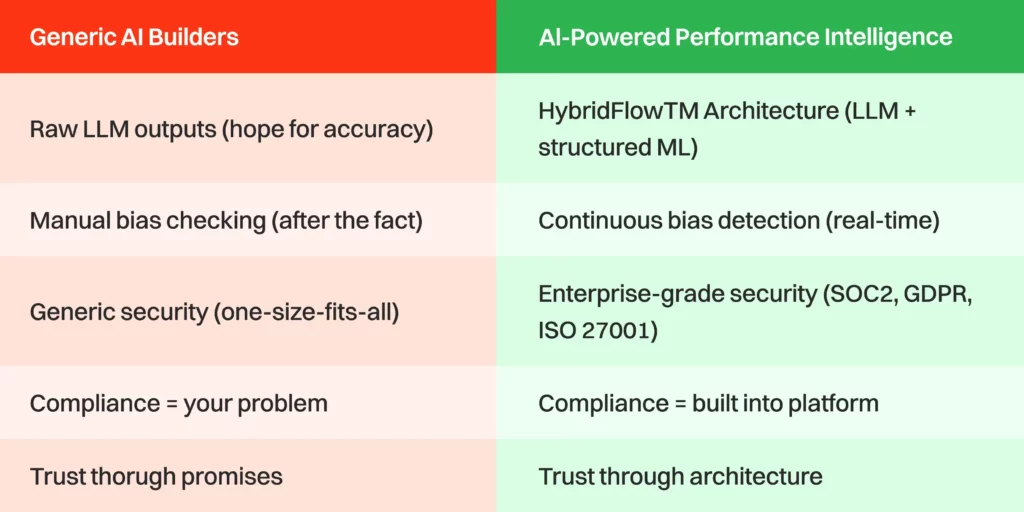
The Difference in Action
❌ Pure LLM Approach (Risky):
“Sarah demonstrated strong leadership in the Q3 product launch.”
Problem: Sounds great, but what if Sarah wasn’t involved in Q3 launch? Pure LLMs can invent plausible contributions that never happened.
✅ HybridFlow Approach (Grounded):
“Sarah demonstrated strong technical problem-solving across 8 projects this quarter. Evidence: Jira completion rate 98% (target: 90%), peer feedback mentions ‘debugging skills’ 23 times across Q1-Q4, zero missed deadlines, resolved critical production issue (Project Phoenix) 48 hours ahead of schedule.”Why this works: Every claim is traceable to source data. Managers can verify. Employees see evidence, not opinions. If challenged, you have documentation.
Built-In Responsible AI (Not Added Later)

Most AI platforms treat responsible AI as optional, features you bolt on, guardrails you build yourself, compliance you figure out later. Why? Because the last thing you need is AI that accidentally discriminates, hallucinates accomplishments, or violates privacy laws.
Lyzr embedded responsible AI into the platform foundation:
- Continuous bias detection – Every output scanned in real-time (not after the fact)
- Grounded reasoning – All insights tied to verified data (no fabrication)
- Explainable decisions – Every recommendation includes evidence trail
- Privacy-first design – Only work-related data, employee visibility controls
- Enterprise compliance – SOC2, GDPR, ISO 27001 certified
Result: You don’t have to build responsible AI safeguards. They’re already there.
How This Compares to What You’re Already Evaluating
Now that you understand how HybridFlow works, you might be wondering:
“How is this different from AI features in our HRIS or performance management platform?”
Traditional HRIS (Workday, BambooHR): AI writing assistants that help you draft 20% faster. Lyzr agents eliminate 70% of the work by handling continuous data collection and synthesis autonomously.
PM Platforms (Lattice, 15Five): AI copilots layered on top of manual processes. You still gather data and synthesize feedback yourself, AI just helps polish. Lyzr provides end-to-end autonomous intelligence.
Build Your Own (CrewAI, Agentforce): 6-12 months development time + AI engineering team required. Lyzr delivers production-ready agents in 8-12 weeks with no AI expertise needed on your team.
Read detailed comparisons: Workday | BambooHR | CrewAI | Agentforce
The Four-Stage Performance Intelligence Loop
Traditional performance reviews fail because they rely on managers to remember, synthesize, and articulate months of performance data. They can’t. Human memory is fallible, biased, and incomplete.
AI Performance Agents solve this by creating a continuous performance intelligence system that operates through four coordinated stages:
- Continuous Data Collection → Automated capture from everywhere work happens
- Intelligent Analysis & Synthesis → Pattern recognition, bias detection, insight generation
- Automated Report Generation → Evidence-based, comprehensive performance summaries
- Personalized Coaching & Development → Actionable guidance for growth

Unlike single-purpose tools, this isn’t one agent doing everything. It’s a coordinated multi-agent ecosystem, like a specialized HR team where each agent has a specific role and hands off work seamlessly to the next.
Let’s break down each stage.
See the Agent Workflow in Action →

Want to see this working with YOUR data?
Book a 15-minute technical walkthrough →
Stage 1: Continuous Data Collection
Automated & Passive: No Extra Work Required
The system begins collecting performance signals the moment an employee joins, building a comprehensive performance profile over time,not just scrambling during review season.
What gets collected:
- Self-assessment submissions
- Manager 1:1 notes and feedback logs
- Peer feedback and 360-degree reviews
- Goal completion and OKR tracking
- Project delivery metrics and timelines
- Training/certification completions
How Collection Agents Work: Parallel, Not Sequential

Traditional systems create bottlenecks. Employee fills out self-assessment → Manager waits → Then manager writes review.
AI agents operate in parallel. Both happen simultaneously and this cuts review cycle time by 40%. By the time employees and managers submit feedback, the system is ready to synthesize immediately.
The system operates through two primary collection agents working at the same time:

Stage 2: Intelligent Analysis & Synthesis
From Raw Data to Meaningful Insights
Once data is collected, AI agents analyze it to identify patterns, trends, and meaningful insights, not just raw data dumps.
Two specialized agents handle this stage:
Meet The Synthesizer: Performance Report Analysis Agent
Function: Synthesizes all collected data, employee self-assessments, manager feedback, and work signals, through your company’s specific performance framework.
Processing time: 2-5 minutes per employee report
What it does:
- Maps employee activities to your performance criteria (OKRs, competency models, rating scales, custom frameworks)
- Identifies strength patterns (repeated excellence across projects)
- Flags development areas (skill gaps or performance dips)
- Tracks progress against goals over time
- Compares performance to role expectations
- Synthesizes diverging perspectives between self-assessment and manager feedback
Customization: Adapts to whatever framework you use: 5-point scales, OKRs, competency models, stack ranking, custom criteria. You don’t change your process, just automate it.
Example transformation:

The difference: Specific, evidence-based, actionable, not vague and generic.
Why this is possible: HybridFlow grounds every statement in verified data. It’s not generating creative fiction, it’s synthesizing documented reality.
Meet The Equity Guardian : Bias Detection (build-in)
Function:
Scans both manager feedback and AI-synthesized analysis for bias indicators before any report is finalized.
Accuracy: 94% bias detection rate in testing
What it detects:
- Language bias: Gendered terms (“abrasive” vs “assertive”), coded language, subjective descriptors
- Recency bias: Over-weighting recent events vs. full review period
- Halo/horn effect: One trait influencing overall rating unfairly
- Comparison bias: Rating against other people vs. objective standards
- Rating inflation/deflation: Patterns across managers showing inconsistency
- Assessment gaps: Inconsistencies between self-assessment and manager feedback that warrant investigation
How it works:
If bias is detected, the agent flags it and suggests neutral reframing before the report is finalized. The manager sees flags during the review process (not after submission) and can revise language, rebalance examples, or dismiss flags with explanation (logged for audit).
Real world scenarios
Example 1: Language Bias

Example 2: Recency Bias

Example 3: Assessment Gap

Action:
Manager receives flags during the review process (not after it’s submitted). Can revise language and rebalance examples before the report is finalized.
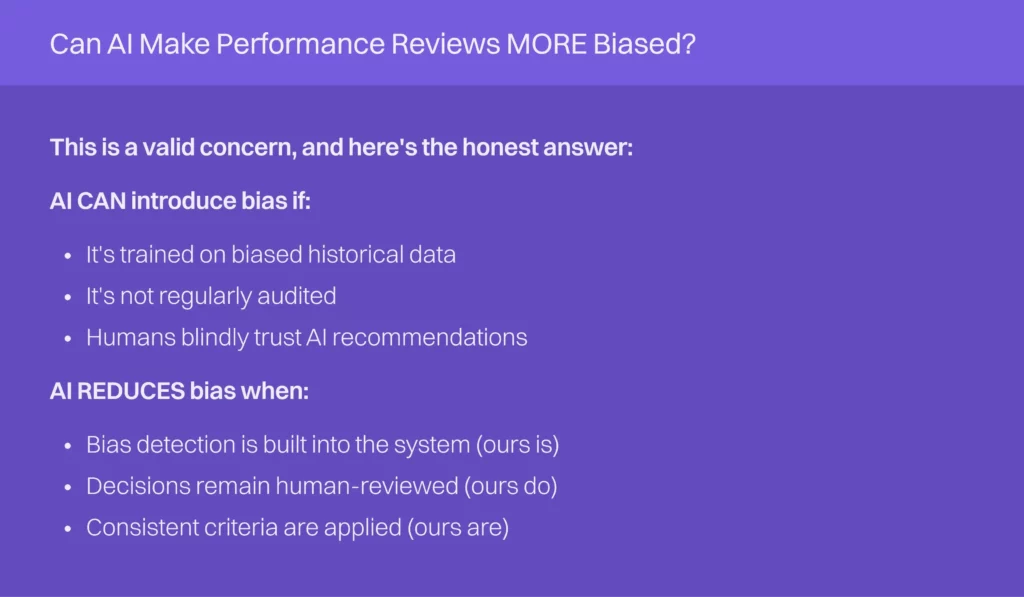
Stage 3: Automated Report Generation
Comprehensive, Evidence-Based Performance Summaries
This is where everything comes together into a final performance review that’s actually useful.
The Core Orchestrator: Feedback Generation Agent

What it does: Combines outputs from Employee Self-Assessment Agent, Manager Feedback Agent, Performance Analysis Agent, and Bias Detection Agent into a consolidated, comprehensive performance report.
Manager time saved: 70% reduction in report writing time (4-6 hours → 15-30 minutes)
What makes these reports different:
- Evidence-based: Every claim backed by specific examples from collected data
- Balanced: Strengths + development areas, with both self and manager perspectives synthesized
- Actionable: Clear next steps, not vague “improve communication skills” nonsense
- Consistent: Same evaluation framework applied to everyone across the organization
- Bias-checked: Already scanned and corrected before manager sees it
Report Structure (What Managers Receive)
1. Performance Summary
Overall assessment synthesizing all feedback sources with key themes
2. Key Strengths
What they excel at, with specific examples from manager feedback, peer mentions, and project outcomes
3. Development Opportunities
Growth areas with specific, actionable recommendations (not generic advice)
4. Goal Progress
Achievements vs. targets with data from project management tools and OKR tracking
5. Self-Assessment vs. Manager Feedback Synthesis
Alignment analysis showing where perspectives match and where they diverge (with context for gaps)
6. Career Development Recommendations
Next role preparation, skill building pathways, stretch assignments
7. Suggested Action Plan
Quarterly development goals with specific milestones
Time Transformation:
What used to take managers: 4-6 hours per employee
(Gathering scattered data, synthesizing feedback, writing from scratch, revising for consistency)
What now takes managers: 15-30 minutes per employee
(Reviewing comprehensive AI draft, adding personal context, refining strategic insights)
What managers do instead:
Review a comprehensive draft that’s 80% complete, add the 20% only they can provide (strategic context, relationship insights, specific opportunities), then have meaningful performance conversations instead of scrambling to remember what happened 6 months ago.
Once reports are generated, HR can view and manage everything through a centralized Performance Review Dashboard.
HR Dashboard : Centralized Performance Management
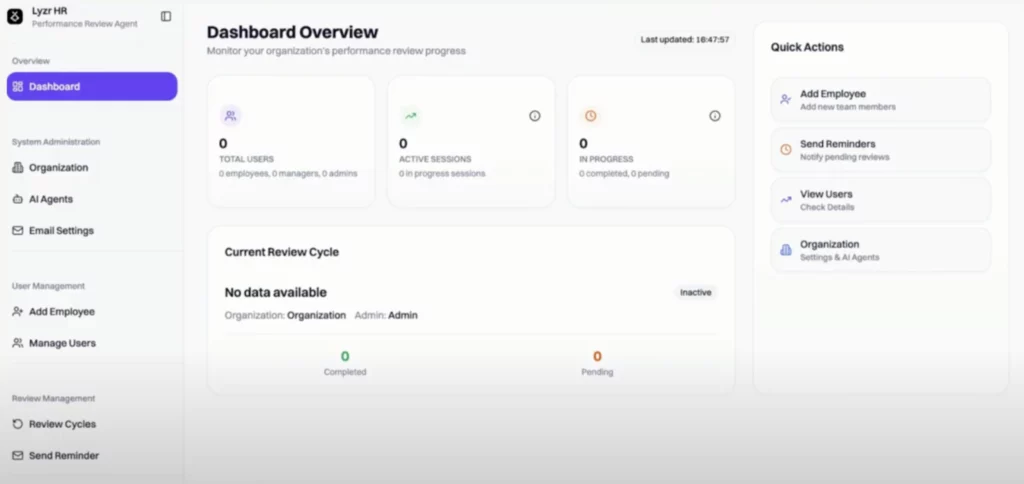
HR Dashboard Capabilities:
- Add employees and managers to the system
- Initiate and track review cycles across the organization
- View consolidated feedback reports in “Manage Users” section
- Monitor completion status (who’s submitted, who needs reminders)
- Export data for HRIS integration
- Run analytics on performance trends across departments, roles, locations
- Generate calibration reports for leadership review
Visibility in real-time:
No more chasing managers via email. Dashboard shows exactly where each review stands: employee feedback received, manager feedback submitted, report generated, manager reviewed, finalized.
[Here’s a 5 step setup process for your Dashboard]
Stage 4: Personalized Learning & Development
Closing the Loop: From Performance Feedback to Measurable Growth
Here’s where most performance management systems die: the feedback.
The manager writes: “Sarah needs to improve stakeholder communication.”
Sarah reads it, nods, and… then what? She’s supposed to magically get better?
Traditional performance management stops at identifying gaps. AI-powered performance management closes them automatically.
The Missing Link: Development That Actually Happens
Performance feedback without development support is just documentation of failure. You identify the gap, the gap stays open, next year you identify the same gap again.
The AI L&D ecosystem connects performance feedback directly to skill development and feeds results back into your next review cycle.
Three specialized agents handle this:
AI L&D Tutor Agent → Delivers Personalized Learning
Automatically delivers the right training when performance reviews identify skill gaps.
How it helps employees: When a performance review identifies a development area like “needs to improve executive communication,” the system automatically acts.
What happens:
- Sends employees specific courses matched to their exact skill gap (not a generic catalog)
- Creates personalized learning schedules based on employee workload and deadlines
- Sequences content by skill level (beginner, intermediate, advanced)
- Delivers in preferred formats (video, reading, interactive, hands-on projects)
Employee experience: One-click enrollment with clear connection to career progression. Employees see exactly how training supports their next role.
Seamless Integration: Syncs with Udemy, Coursera, LinkedIn Learning, custom enterprise LMS
Learning Analytics Agent → Tracks Skill Application
Evaluates whether employees actually apply what they learn, not just whether they completed a course.
Why this matters: Traditional L&D stops at “course completed ✓”
This system measures: “Are employees demonstrating new skills in their actual work?”
What it tracks:
- Course completion and engagement patterns
- Knowledge retention through assessments
- Skill application in real work (connected to performance data)
- Learning velocity and style preferences
- Progress toward development goals
The impact: Next performance review doesn’t just show “completed communication training.” It shows “Led 4 executive presentations post-training, up from 1/month. Stakeholder satisfaction improved 17%.”
Your team gets credit for real development, not just checkbox completion.
AI Assessment Agent → Feeds Progress Back to Performance System
Generates insights for employees, coaching prompts for managers, and workforce intelligence for HR, all connected back to performance goals.
What you get:
For Employees:
- Personal learning dashboard with progress tracking
- Skill application insights (“You’ve led 4 stakeholder meetings since training up from 1/month”)
- Career readiness visibility (“You’re 70% ready for Senior PM role”)
For Managers:
- Coaching prompts when direct reports complete relevant training (“Sarah ready for executive presentation opportunity”)
- Team development visibility (who’s learning what, who’s ready for stretch assignments)
- Data connecting training completion to performance improvement
For HR Leadership:
- Strategic workforce development reports
- Learning ROI metrics (investment vs. measurable performance improvement)
- Succession pipeline visibility (who’s demonstrating readiness for next-level roles)
- Career development plans linked to business needs
Why this matters for your organization: Development progress automatically feeds into the next performance cycle. Growth is documented with specific examples. You can prove L&D investment drives performance outcomes.
The Performance Management Impact
Companies that integrate learning with performance management see:
Why? Because performance management that connects feedback to development, and measures the results actually improves performance. Traditional reviews just document it.
Will this work with OUR tech stack, OUR performance framework, OUR organizational structure?
There’s only one way to find out.
Book a 15-Minute Product Walkthrough →
We’ll show you:
✓ The agent workflow with your specific performance criteria
✓ Integration with your existing HRIS and tools
✓ Security, compliance, and customization options
✓ Implementation timeline for your organization size
No generic demo. No sales pitch. Just your specific questions answered.
You’ve seen how agents transform performance reviews. But, here’s what most organizations miss: Performance insights should trigger action across your entire HR operation, not just sit in a review document.
When Sarah’s review identifies leadership readiness, that insight should automatically update succession planning, inform compensation decisions, shape hiring criteria for her team, and trigger workforce planning adjustments.
But it doesn’t. In traditional systems, performance data stays trapped in its own module. HR manually exports spreadsheets. Insights get lost between quarterly reviews. Strategic decisions get made without your best available intelligence.
This is where individual agents become something bigger.
Meet Diane: The HR Operating System
The agents you’ve just seen: Data Collection, Performance Analysis, Bias Detection, Feedback Generation, L&D don’t work in isolation. They’re coordinated by Diane, the Superagent that orchestrates specialized agents across your entire HR lifecycle.
Think of it this way:
Performance agents = Your specialized team members
Diane = The operating system that helps them work together seamlessly
What Diane Does:
While this playbook focuses on performance management, the same agent infrastructure powers:
- Talent Acquisition → Screen 1,000+ resumes/minute with competency models from your top performers
- Onboarding → 90% time reduction with personalized learning paths
- Workforce Planning → Skills gap analysis and succession pipeline visibility
- Retention Analytics → Predictive attrition modeling and intervention triggers
- Payroll & Operations → Automated compliance and policy generation
Why this matters: Your performance data automatically flows where it’s needed. Sarah’s leadership readiness updates succession planning while triggering compensation analysis while informing hiring requirements for her team. No manual exports. No lost insights. Just continuous organizational intelligence.
Ready to see Diane in Your Environment?
We’ll show you:
✓ How DIANE integrates with your existing tech stack (HRIS, ATS, LMS)
✓ The complete agent workflow customized for your performance framework
✓ Security, compliance, and data governance
✓ Implementation timeline for your organization size
No generic demo. No sales pitch. Just your specific questions answered.
Chapter 4
Making It Work Inside Your Org
Implementation Strategy Without the Meltdown
Let’s talk about the thing nobody admits: most HR tech implementations fail.
Not because the technology doesn’t work. Because implementations take 6-12 months, require expensive consultants, disrupt everything, and by the time you’re finally live, half your managers have tuned out and the executive sponsor has moved on to the next shiny initiative.
Here’s the good news: AI performance agents are different.
Different how? They don’t replace your systems, they overlay them. They don’t require massive change management, they eliminate busywork. And they don’t take a year to implement, most organizations are live in 90 days.
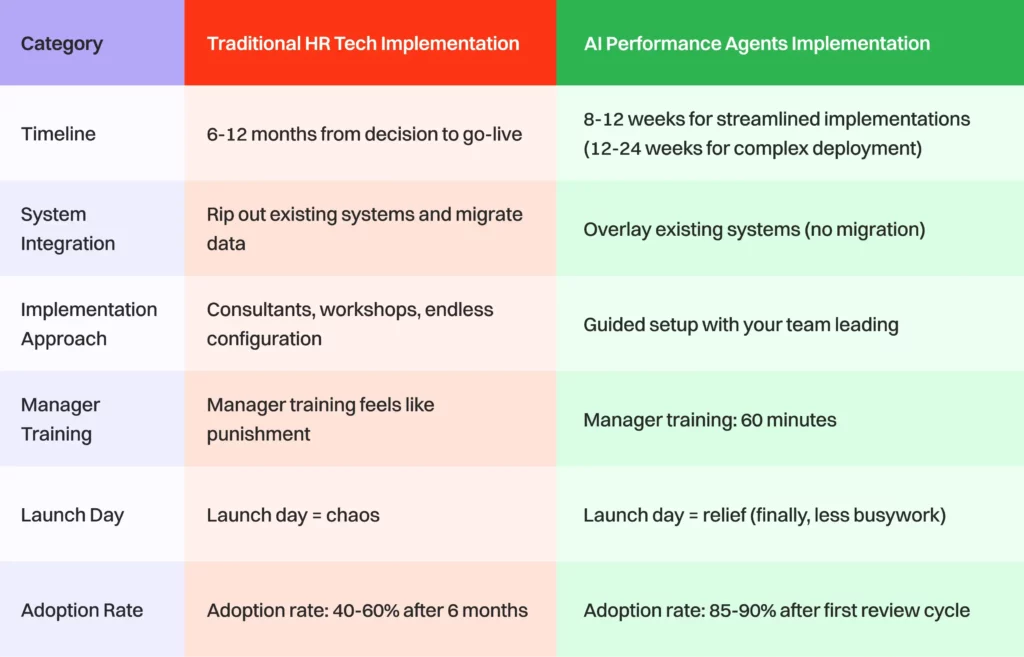
But (and this is important) they’re not magic. You can still screw this up. Not through bad technology, but through bad implementation strategy.
The Implementation Roadmap
Timeline Overview
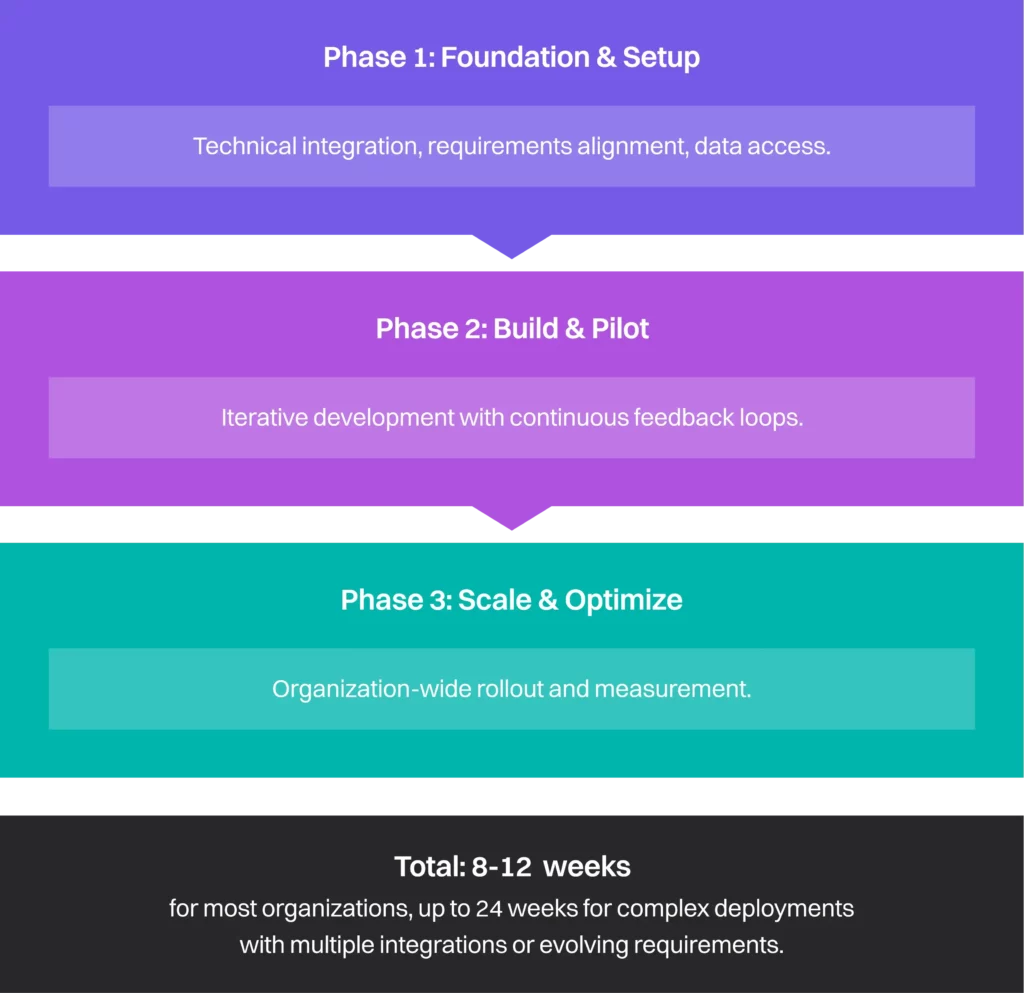
Before You Begin – Are You Ready?
The Pre-Implementation Checklist Nobody Talks About
Before you dive in, ask yourself: Should you even start right now?
Most implementation failures happen because organizations rush in without checking if they’re ready. Not technically ready, organizationally ready.
The Readiness Check: 5 Questions

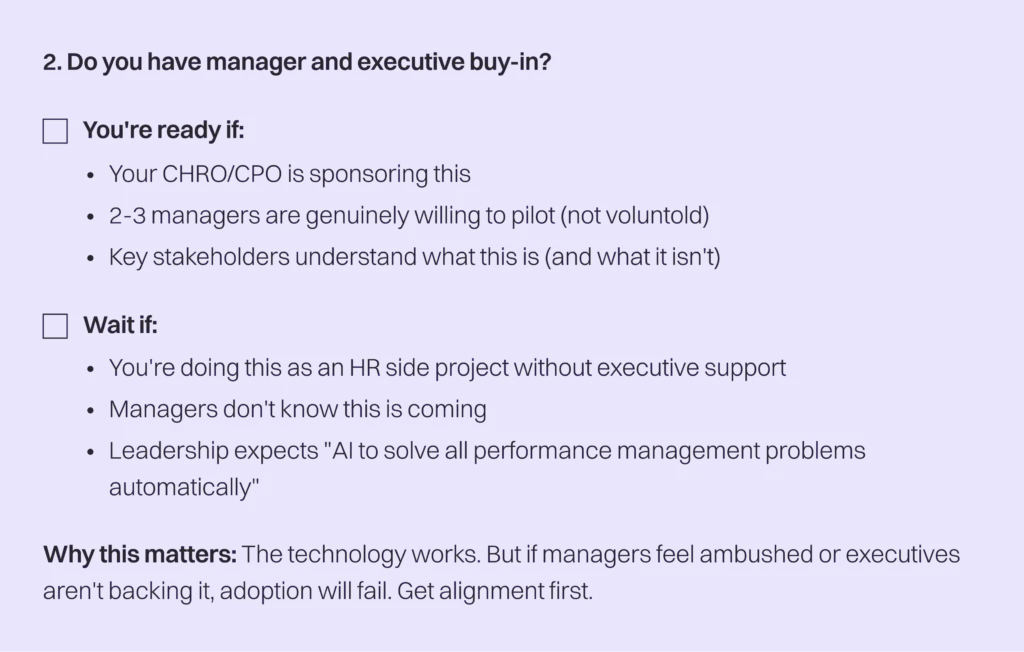
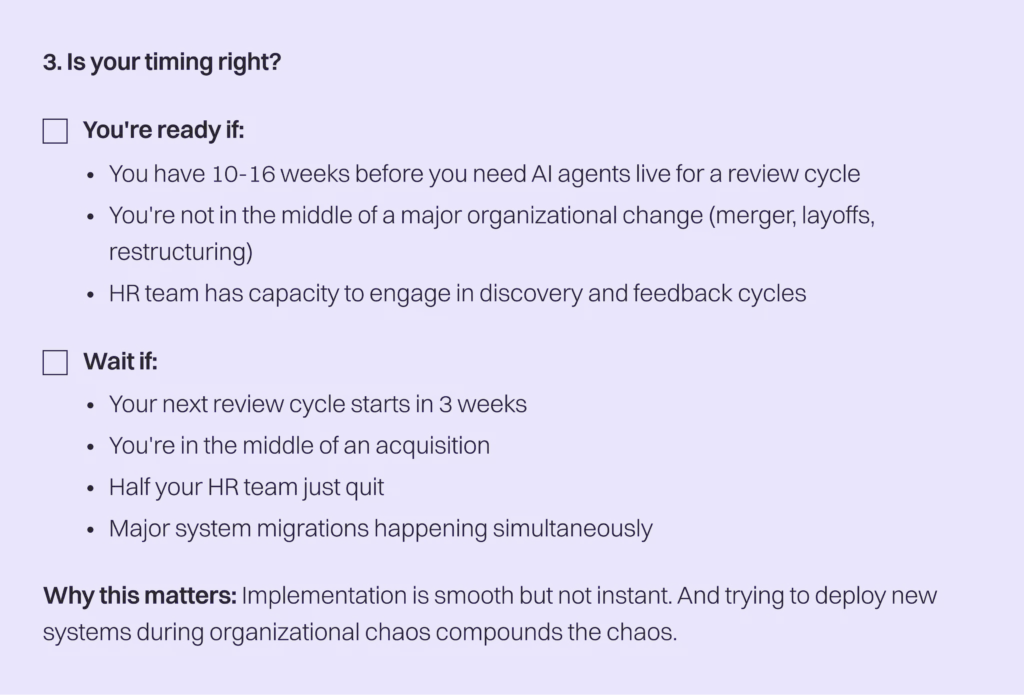


Your Readiness Score
5 out of 5 green checks? → Start now.
3-4 green checks? → Addressable gaps. Fix them first, then start.
1-2 green checks? → Not ready. Solve foundational issues before adding technology.
Phase 1: Foundation & Setup
What happens:
- 2-3 discovery sessions to align on use cases, desired outcomes, and data availability
- Map current performance management workflow and pain points
- Identify pilot group (20-50 employees, 2-3 willing managers)
- Define success metrics and integration scope
Key deliverable: Clear documentation of what data exists, what AI agents will do, and realistic expectations based on available data.
What gets connected:
Not everything needs to integrate Day 1. Start with essentials, add more later.
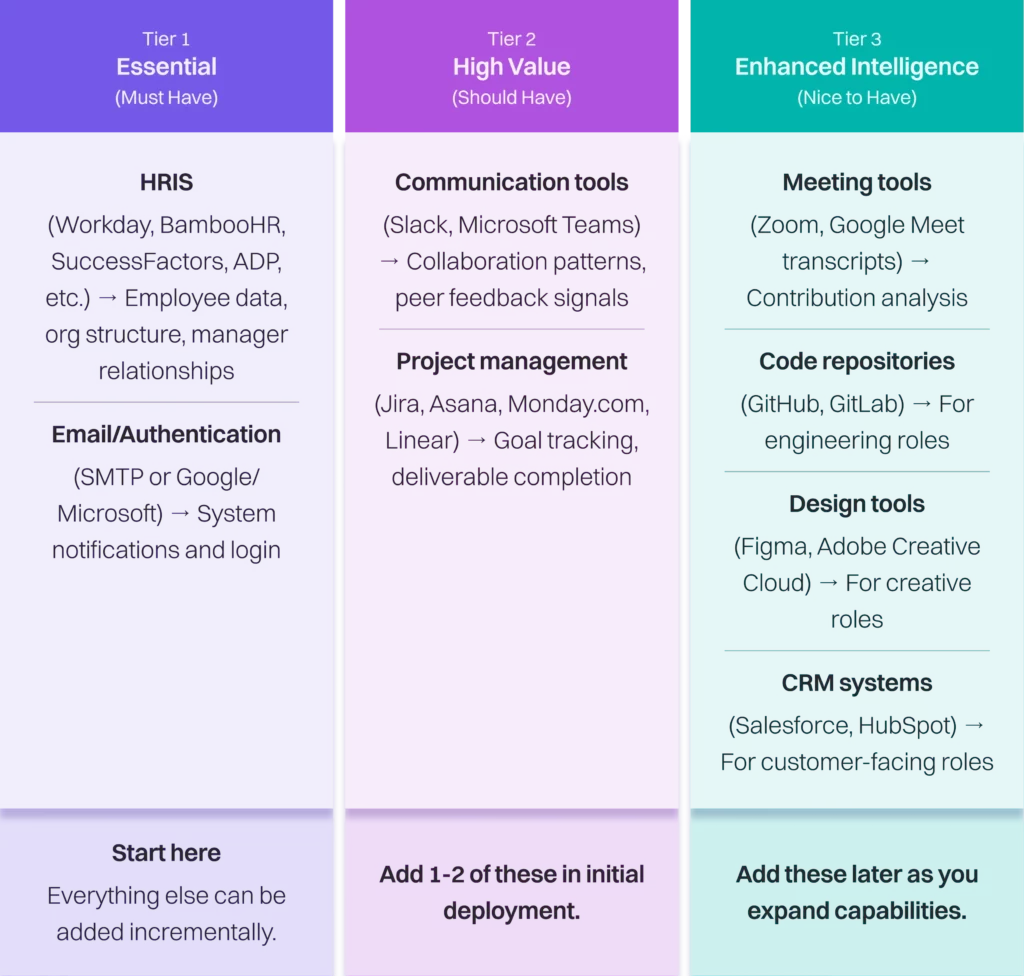
What happens:
- IT/Security reviews and approves data access
- API connections configured with read-only permissions
- Performance criteria and templates customized
- System tested in sandbox environment with synthetic data
- Security audit and compliance sign-off
Key deliverable: Fully integrated system in test environment, ready for pilot activation.
Phase 2: Build & Pilot
Instead of months of black-box development with a big reveal at the end, you’ll see working demos every 2 weeks and provide feedback that shapes the final system.
Why this works: Requirements evolve when you see AI agents working with your actual data. This is normal and expected.
Sprint 1: Foundation Build
Development: Core functionality with basic UI, self-assessment collection, manager feedback input, initial report generation (80% complete), basic bias detection
Data collection begins: AI agents start passively collecting performance signals from integrated systems. Employees and managers use tools normally, no behavior change required.
Communication: Notify pilot employees that data collection is starting, explain what’s being analyzed and why, emphasize transparency and work-related data only.
Sprint 2: First Demo & Refinement
First demo: System generates sample performance report drafts for 3-5 pilot employees. Hold 90-120 minute review session with pilot managers to walk through reports, gather feedback on accuracy and completeness, identify what’s missing or needs refinement.
Refinement cycle: Development team incorporates feedback, template adjustments, language refinements, development recommendation specificity, additional data source integrations if needed. Plus: Build next 30-40% of features (bias detection refinements, AI Coach interface, HR dashboard).
Expected feedback: “This captured 70% of what I need, but I’d add context about X” or “This missed Y project, can we integrate that data source?” This is exactly what you want to hear.
Sprint 3: Complete Build & Live Pilot
Final development: Complete remaining functionality, polish all report sections, finalize bias detection rules, complete AI Coach capabilities, build HR dashboard analytics.
Manager Training:
- Live demo of reviewing and editing an AI-generated report
- Hands-on practice with their actual pilot reports
- Q&A and troubleshooting
- Keep it simple: “Here’s your draft. Review it. Edit it. Use it.”
Live pilot: Pilot managers conduct actual performance reviews using AI-generated drafts.
Key deliverable: Validated system with manager champions, documented time savings and quality improvements, employee satisfaction data, readiness decision to scale.
Phase 3: Scale & Optimize
The pilot worked. Managers are seeing value. Employees appreciate more comprehensive feedback. Time to scale.
Common fear at this stage: “What if the pilot was a fluke and it fails at scale?”
Reality: If your pilot was properly diverse (multiple managers, different team types, real review conversations with actual performance decisions), then scaling is mostly logistics and change management, not technical risk.
The real risks now are:
- Communication breakdown (people don’t understand what’s happening)
- Support overwhelm (too many questions, not enough help capacity)
- Rushed rollout (didn’t give organization time to adjust mentally)
Let’s avoid all three.
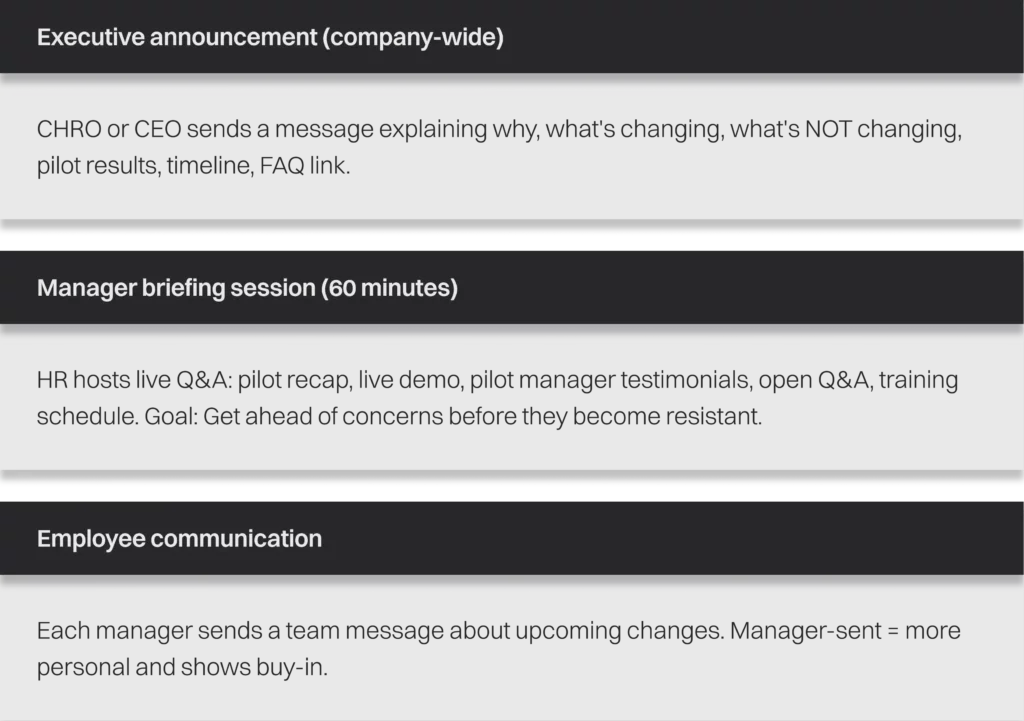
Retrospective session: 90-minute session with pilot managers, HR team, key stakeholders to document what worked, what didn’t, what to do differently next cycle, and future roadmap.
Key deliverable: Documented ROI with specific metrics, optimization roadmap for next cycle, executive summary for leadership, baseline established for future comparison.
Critical Success Factors
Three things that make or break implementation:
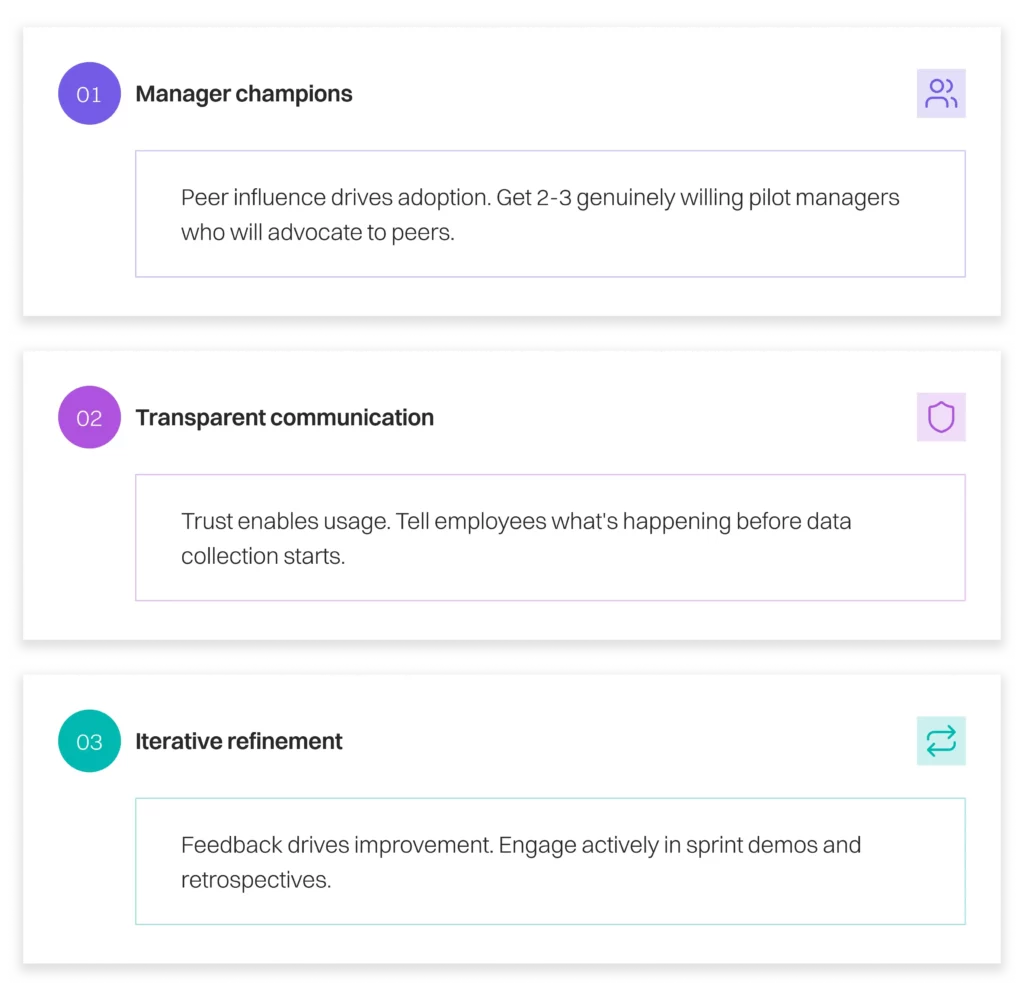
Get these right, and the technology takes care of itself.
Timeline Expectations: The Honest Truth
What Drives Your Timeline?


Our Recommendation
Plan for 16 weeks.
- Finish in 10? Excellent.
- Need 20 because scope expanded? Also fine.
Better to set realistic expectations than overpromise and underdeliver.
What to Track Post-Implementation

Industry Benchmarks: How You Compare
Use these benchmarks to assess your performance relative to industry patterns and track your progress against AI-assisted targets:




The Bottom Line
Implementing AI performance agents isn’t a risk, it’s one of the highest-ROI investments HR can make.
The math works. The benchmarks prove it. The causal chain holds.
The question isn’t “Can we afford to do this?”
The question is “Can we afford NOT to?”
Every manual review cycle burns $180K+ in manager time while delivering mediocre feedback that disengages your best talent.
Stop burning money. Start building competitive talent advantages.
Chapter 5
Case Studies & Proof Points
The Framework Built on Validated Results
Here’s the honest truth about AI performance management ROI: We don’t have 50 customer case studies showing 10-year performance management tracking.
Why? Because AI agents in performance management are emerging technology. The category is new.
But, we have something better: Validated results from Lyzr implementations across HR automation use cases that follow identical economics.
Performance management, recruiting, HR operations, and document analysis all share the same value drivers:
- High-volume, repetitive work
- Time-intensive data synthesis
- Manual coordination overhead
- Manager/employee time consumption
- Quality inconsistency from human variability
When Lyzr automates these processes, the results are consistent.
Proven Across 3 Lyzr HR Implementations:

Same economics. Same results.
What This Means for Performance Management
Performance management automation follows the same proven patterns we’ve seen across Lyzr’s HR implementations. Here’s what the data shows:
Three Validated Performance Patterns
Pattern 1: Time Savings Through Automation
Proven by: Keka HR (AI Hiring Assistant)
What they achieved:
- 50% time savings – Recruiters drastically reduced administrative overhead
- Consistent quality – Clearer job descriptions attract better-fit applicants
- Improved experience – Streamlined scheduling and timely notifications
How this applies to performance management:
- AI automates data gathering across multiple systems
- Eliminates manual synthesis of feedback from scattered sources
- Auto-generates structured performance reports
Your expected outcome: 50-60% reduction in manager time per review cycle (15-17 hours → 4-6 hours)
Industry Validation:
- Betterworks 2025 Global HR Research: 89% employee satisfaction with AI-assisted reviews (vs. 57% with traditional)
- Culture Amp State of Employee Experience 2024: 58% higher manager confidence with data-driven insights
Pattern 2: Quality & Consistency Gains
Proven by: Saksoft (Multi-Agent HR System)
What they achieved:
- 60% operational cost reduction – Saved $2.8M annually through automation
- 5 FTE capacity freed – HR team redirected to strategic work
- 95% HR query resolution accuracy – High-quality automated responses
- 50% boost in development velocity – Faster processes, better outcomes
- 92% test coverage, 35% fewer bugs, 45% faster feature releases
How this applies to performance management:
- Standardized evaluation criteria applied uniformly
- Bias detection catches problematic language before reviews finalize
- Evidence-based feedback replaces memory-based assessments
- HR capacity freed from coordination to strategic talent work
Your expected outcome:
- 30-40% improvement in feedback comprehensiveness
- 90%+ bias flag resolution rate
- 60% reduction in HR coordination overhead
Industry Validation:
- Lyzr customer data: 30-40% more comprehensive reviews captured
- Gallup State of the Global Workplace 2023: Employees who receive meaningful feedback are 3.5x more likely to be engaged
- Harvard Business Review 2019: Recognition and feedback ranked #2 driver of employee engagement
Pattern 3: Cycle Time Compression
Proven by: Yardstick (Policy Coverage Review Assistant)
What they achieved:
- Review cycles: Days → hours – Dramatic time compression in document analysis
- Clearer visibility – Identifies fully/partially addressed or missing themes in complex documents
- Actionable insights – Evidence excerpts, relevance scores, structured outputs
Validated across implementations:
- Saksoft: QA cycle time: 8 weeks → 2.5 weeks (68% reduction)
How this applies to performance management:
- Review cycles compress from weeks of coordination to days
- Real-time performance insights replace quarterly retrospectives
- HR coordination shifts from 6 weeks intensive → 3-5 days monitoring
Your expected outcome: 68% reduction in review cycle coordination time
Pattern across all case studies

Total Business Impact with AI Powered Performance Enablement

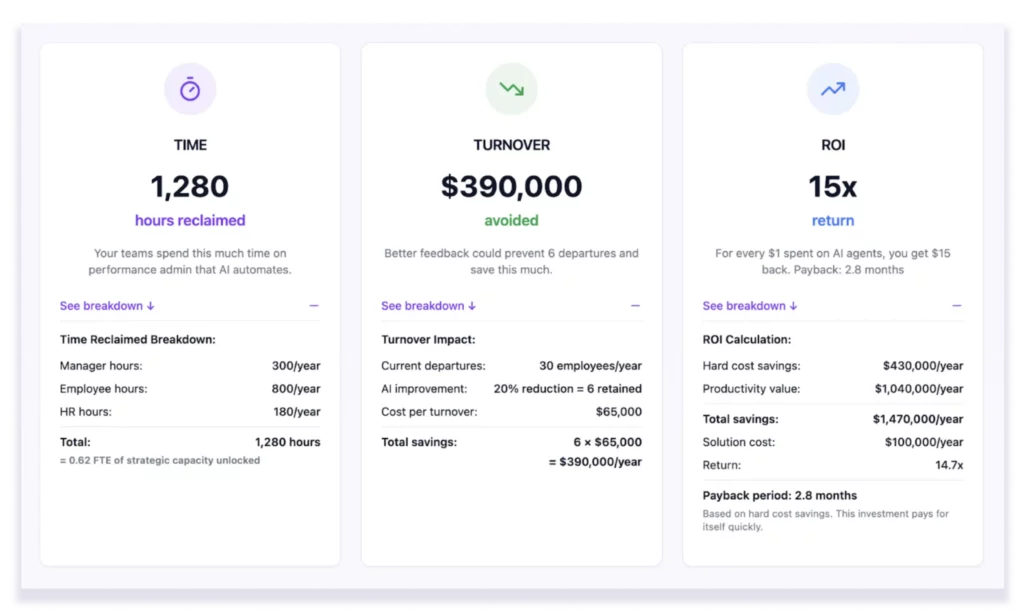

Next Steps
What Happens Next?
You’ve seen the data. You understand the opportunity. Now it’s time to choose your path forward.
We built this playbook because we were tired of watching smart HR leaders get stuck in manual performance management hell. You deserve better tools. Your managers deserve less busywork. Your employees deserve feedback that actually helps them grow.
So pick your path below, no pressure, no sales tricks, just the next logical step based on where you are right now.
What’s your next move?
Path 1: Show Me The Numbers
For the strategist who needs ammunition
What you’ll get:
✓ Detailed cost analysis by category (time, turnover, bias, strategic misalignment)
✓ 12-month ROI projection with implementation timeline
✓ Comparison to industry benchmarks for your sector and company size
✓ Specific AI agent recommendations for your biggest pain points
✓ Executive summary for the leadership
Path 2: Show Me How It Works
For the doer who’s ready to see it live
What you’ll see:
✓ AI agents analyzing real performance scenarios
✓ Integration with specific HRIS/tools
✓ Your use cases demonstrated live
✓ Implementation proposal and pricing
Not Ready for Any of These?
We get it. Sometimes you need to sit with the ideas before taking action.
Here’s what to do instead:
Read the blueprint: See the technical architecture behind AI performance agents and how they integrate with your existing stack. AI Performance Review Agent Blueprint →
Compare options: Understand how Lyzr’s approach differs from traditional HR platforms, AI writing tools, and other agent solutions. Solution Comparison Guide →
Stay informed: Download the State of AI Agents report to see where the market is heading and what forward-thinking organizations are building. State of AI Agents 2025 →

